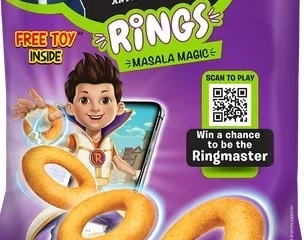Hidden Dangers: How Food Marketing Tactics Impact Children’s Health

Back in the 1990s, an indigenous chips brand captured our hearts with its iconic tagline, “Bole Mere Lips, I Love …………. Chipps.” However, this cherished Indian brand eventually succumbed to the competition from an international MNC with a clever strategy – offering small, collectible discs adorned with cartoon characters called ‘tazos’ for free with every chip pack. For kids like me, it became a mission to collect as many tazos as possible, convincing our parents to buy more chips. We formed teams with friends and cousins, all driven by the excitement of the chase. As a result, the indigenous chips brand, once a household name, faded into obscurity. This nostalgic anecdote underscores the immense influence of food marketing tactics aimed at children. Do you also recall the maze of offers from a famous international fast-food chain, luring us with free toys? Behind the appeal of these giveaways lay meals laden with calories, low in fibre and protein, and drowning in sugar, not to mention the sugary drinks they bundled. Food marketers employ a range of strategies to captivate young palates, aiming to foster lifelong brand loyalty. If successful, they not only secure the children’s market but also pave the way for their brands to thrive among adolescents and adults in the future. In this article, we delve into these common food marketing tactics and offer parents valuable insights and tips to help their children make healthier food choices.
Richa Pande
In the world of children’s food choices, marketing wields substantial power. Be it through eye-catching packaging or irresistible characters, marketing has a knack for igniting cravings in the little ones. Sadly, a significant portion of this marketing sorcery is directed towards promoting less-than-healthy packaged snacks and treats, often loaded with sugar, fat, food additives which might not be good for children health. This marketing frenzy plays a pivotal role in the concerning surge of childhood obesity, calling for immediate attention. But here’s a glimmer of optimism! Parents have the potential to make a positive impact by staying informed and getting involved.
Join us as we explore the captivating realm of marketing, unhealthy snacks, and how parents can make a difference. And that begins with learning about the existing food marketing strategies targeting children. Here are some promotional strategies recruited by food marketers-
Stress can also be bad for your heart health as stress can cause irregular heart rate and rhythm, increased blood pressure, chronic intrinsic inflammation, and reduced blood flow to the heart. These hormonal surges can damage blood vessels and arteries, increasing blood pressure and raising risk of heart attacks or strokes. Prolonged stress can have negative impact on your digestive health as well. It can cause acid reflux, diarrhoea, constipation, stomach aches, heartburn, and can also increase your risk for having ulcers. Stress can also contribute to the build-up of adipose tissue and weight gain by increasing appetite and increasing storage of unused nutrients such as fat. Release of these stress hormones can weaken your immune system and reduce body’s response to infections. Individuals experiencing chronic stress are more susceptible to infections and prolong recovery from an illness or injury. Individuals with chronic stress can also experience behaviours such as overeating, alcohol or drug abuse, and social withdrawal. Stress can also lead to irregular, heavier, or more painful periods in women and can worsen the symptoms of menopause in women.
Food Advertisements on Children’s Television
Food advertisements on television exert a significant influence on children’s food choices, often playing a pivotal role in shaping their dietary preferences and habits. These advertisements are strategically designed to appeal to the sensory and emotional aspects of childhood, showcasing enticing visuals, catchy jingles, and beloved characters. When children are repeatedly exposed to images of foods high in Sugar, Fats, and Salt (HFSS Foods), it creates a powerful association between these products and feelings of happiness and pleasure. This can lead children to desire and request these foods from their parents or caregivers. Moreover, the persuasive tactics employed in these advertisements can override children’s ability to make informed, health-conscious choices. As a result, there is a concern that excessive exposure to food advertising, particularly for unhealthy products, contributes to childhood obesity and related health issues.
Cartoons on packaged foods
Cartoons featured on packaged foods hold a substantial sway over children’s food choices, making it a potent marketing tool. These colourful characters and mascots create an immediate and lasting impression on young minds, associating the product with fun and excitement. Children are drawn to the familiar and friendly faces. This phenomenon often leads to pester power, as kids request products featuring their favourite characters.


Popular Cartoons on Packaged Foods available in Indian food market {Name of the Brands Hidden}
Product Placement in Kids’ favourite cartoon shows
Product placement of unhealthy foods in kids’ cartoons can shape children’s food preferences and health negatively. Advertisers often use this tactic to make unhealthy foods and beverages appealing to young viewers. Such exposure can lead to poor eating habits, obesity, and related health issues. Children, being influenced by their favourite animated characters, may develop cravings for these products. This blurs the line between entertainment and advertising, making it hard for children to discern between content and commercials.
Product placement in story narratives of kinds’ favourite comics
Product placement in children’s comics subtly shapes preferences and choices, leveraging the emotional connection between beloved characters and products. By seamlessly integrating into storylines, it fosters positive associations, instilling familiarity and trust with the items showcased. This strategy effectively influences young readers’ behaviour while maintaining the enjoyment of storytelling.

Product Placement in a story narrative of a Popular Children Magazine {Name of the Brand Hidden}
Freebies with packaged foods
Freebies such as toys, puzzles, interactive games holds a considerable influence over children’s choices, as marketers recognize the allure of immediate gratification and psychological ownership in young minds. When presented with a choice, children often opt for products that come with enticing freebies like toys, stickers, or snacks, creating a sense of attachment to the brand. Their pestering power can also sway parental decisions, as caregivers may yield to their requests when a child fervently desires a product bundled with a free item. Collectible freebies further enhance this effect, encouraging children to choose products that complete their sets. Additionally, freebies can foster brand loyalty by associating positive emotions with a particular brand. The influence of peer pressure, limited availability, and compelling advertising further intensifies this effect, as children strive to fit in, seize scarce opportunities, and embrace trends. Furthermore, freebies serve as a means of introducing children to new products, potentially shaping their preferences and choices in the long run. In this way, freebies exert a multifaceted influence on children’s decision-making processes.

Offers on a food packaging
Game Websites by Brands
Food brand-developed game websites have a significant impact on both children and adolescents’ food choices through addictive game design and the promotion of unhealthy products. These games are engaging and rewarding, keeping young players exposed to brand messaging and products. They prominently feature less nutritious items, normalizing and making them appealing to both children and adolescents. The addictive nature, combined with this promotion, forms strong associations, potentially leading to unhealthy eating habits.
QR codes on package foods
QR codes on food packaging can strategically boost brand recall and influence product choice among adolescents and children. These codes encourage interaction, allowing kids to scan and engage using their devices, creating a direct link to the brand. Interactive experiences, especially tied to games or exclusive content, enhance brand recall. Children associate the brand with this engaging interaction, potentially leading to preferences during shopping. The excitement shared with parents fosters trust, influencing parents’ positive views and purchase decisions based on the brand’s interactive and educational content through QR codes.
Cashback schemes on packaged foods
Similar to QR codes, cashback schemes and other promotions featuring cartoons on food packaging can encourage children to choose specific products. These incentives offer a tangible benefit, making the product more appealing to both children and parents. The presence of cartoons further enhances the appeal, as they resonate with young consumers.
Contests by food brands promoted on packaged foods and social media channels
Food brands hosting contests on their products and social media channels is like adding some spice to their marketing recipe. These contests are super engaging, especially for teens, with cool prizes and interactive fun. Teens love to share their contest experiences on social media, spreading the brand’s name far and wide. This boosts brand recognition among the younger crowd. Plus, these contests create excitement and make the brand feel like a friend. This can nudge teens towards buying more of that brand’s products, building loyalty. In a nutshell, these contests use social media’s magic to grab teens’ attention and get them munching on those tasty treats.
Look at the nutrient profile of some of the packaged products that had components pertaining to Promotional Tactics Present on Packaged Foods Targeting Children-
|
Food Category |
Nutrient Profile Per 100 g of the product |
Ingredient List |
Promotional Tactics Present on Packaged Foods Targeting Children |
|
Chocolate 16 g pack |
Energy: 468 kcal Protein: 3.6 g Fat: 17.5 g Saturated Fat: 17.3 g Trans Fat: 0.2 g Carbohydrate: 75.1 g Sugars: 70 g Sodium: 74 mg |
Sugar, Hydrogenated Oils, Cocoa Solids (8%), Lactose-Rich Deproteinized Whey Permeate Powder, Milk Solids, Refined Wheat Flour (Maida), Emulsifiers (414, 442, 476), Colours (171, 102, 133, 124, 127, 122, 132, 110), Glazing Agent (903), Liquid Glucose, Flavours (Natural, Nature Identical and Artificial (Caramel And Vanilla) Flavouring Substances). |
|
|
Snack Rings 75 g pack |
Energy (Kcal) 493, Total Carbohydrates (G) 67, Added Sugars (G) 6.9, Dietary Fibre (G) 2.2, Protein (G) 5.4 Total Fat (G) 22.5, Saturated Fat (G) 10.4, Monounsaturated Fat (G) 9.4, Poly Unsaturated Fat (G) 2.6, Trans Fat (G) 0.01, Cholesterol (Mg) 0, Sodium (Mg) 830 |
Corn Flour (70%), Refined Palm olein Oil, Seasoning (Sugar iodised Salt. *Spices and Condiments (Contains Onion and Garlic), Black Salt, Acidity Regulators (INS 296, INS 330), Flavour Enhancers (INS 627, INS 631), Tomato Powder (1.4%), Tamarind Powder, Hydrolysed Vegetable Protein (Soya), Anticaking Agent (INS 551), Colour (INS 160c). Natural and Nature Identical Flavouring Substances). Anticaking Agent (INS 170). *Used as natural flavouring agent |
|
|
Chocolate Cake 120 g pack |
Energy (kcal) – 402 Total Fat (g) – 18.00 Saturated Fat (g) – 8.90 Monounsaturated (g) – 6.18 Poly unsaturated (g) – 1.56 Trans Fat (g) – <0.2 Carbohydrates (g) – 54.51 Sugar (g) – 26 Dietary Fibre (g) – 0.5 Protein (g) -5.48 Sodium (mg) – 200 |
Water, Refined Wheat Flour, Sugar, Palm Oil, Margarine (Partially Hydrogenated Oil, Palm Olein, Palm Oil And Palm Kernel Oil, Whey Powder, Penta Mix, Edible Starch, Emulsifiers, Acidity Regulators, Stabilizers, Anticaking Agent, Humectant, Raising Agents, Acidity Regulators, Preservatives, Added Artificial Flavours Of Mix Fruit And Vanilla |
One of India’s widely recognized cartoons featured on food packaging |
What parents can do to tackle food marketing techniques targeting their children?
Parents play a crucial role in protecting their children from the pervasive influence of food marketing techniques targeting them. Here are some strategies and actions parents can take to tackle this issue:
- Stay Informed
Staying informed about current research and guidelines on child nutrition and food marketing is crucial for making informed decisions about your family’s diet. It ensures you’re up to date with the latest insights on healthy eating and allows you to adapt your food choices based on evidence-backed recommendations, promoting better overall health and well-being for your children.
- Create a Healthy Food Environment
Maintaining a healthy food environment at home is vital. By stocking up on nutritious snacks and minimizing the presence of sugary or highly processed foods, you create an environment that encourages healthier eating habits. This approach supports better dietary choices for your family and reinforces the importance of nutritious options.
- Limit Screen Time
Limiting screen time, which includes TV and internet usage, is crucial in reducing children’s exposure to pervasive food marketing. By curbing screen time, parents can create an environment with fewer opportunities for advertisers to target their children with unhealthy food promotions. This measure allows parents to exert more control over their child’s media consumption and helps shield them from persuasive marketing tactics, promoting healthier food choices and behaviours.
- Read Food Labels Together
Engaging children in reading food labels during grocery shopping is an educational and empowering strategy. It encourages kids to develop essential skills in assessing food products, including ingredient identification, and interpreting nutritional information. By explaining aspects like sugar, salt, and fat content, parents help children make informed food choices. This collaborative approach not only fosters a deeper understanding of nutrition but also instils a lifelong habit of mindful food selection, promoting healthier eating habits.
- Educate your child and enroll them in Nutrition Literacy Programs
Clarify how corporations employ vibrant packaging, enticing slogans, and engaging characters to present unhealthy foods in an attractive manner. Following that, you can encourage participation in literacy programs aimed at teaching individuals how to critically evaluate food marketing tactics and instruct them on utilizing food labels to make well-informed dietary decisions.
- Advocate for Change
Parents can advocate for change by joining advocacy groups or engaging in campaigns to restrict advertising of unhealthy foods to children, making a substantial difference in food marketing practices.
- Lead by Example
Model healthy eating behaviours and food choices to reinforce good habits. When children see parents making nutritious choices and enjoying wholesome meals, they are more likely to follow suit. This positive influence helps create a lasting foundation for a healthy relationship with food and nutrition.
